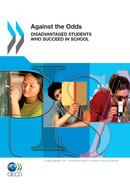
OECD (2011), Against the Odds: Disadvantage Students Who Succeed in School, OECD Publications.
Portugal is one of the OECD countries that has a higher proportion of resilient students, although their proficiency levels tend to be low.
Against the Odds: Disadvantage Students Who Succeed in School (OECD, 2011) is a recent analysis of PISA 2006 which focus on students that despite a disadvantaged situation succeed at school: resilient students. There are some international differences on the prevalence of resilient students: while the OCDE average is 39%, in Portugal these students represent 46.2% of the disadvantaged students. Portugal is the 6th of the 30 OECD countries with a higher proportion of resilient (see Figure 1).
It should be emphasized that the relation between countries global performance and the prevalence of resilient students is ambiguous. Although the recent progress in PISA 2009, Portugal presents lower levels of proficiency in the different PISA inquiries when compared to the OECD countries. But regarding the proportion of resilient students it has a favorable position. In Greece, which usually has PISA global results similar to those of Portugal, the prevalence of resilient students is lower (31.5%) – below the OECD average.
On the other hand, we find countries like Finland, Japan and Canada which combine a general good performance of their students with a high proportion of resilience (66.6%, 52.8% and 51.3%). However, there are also countries among those with the best overall results in PISA 2006 that have a proportion of resilient students below the OECD average, such as Sweden (36.3%), Belgium (37.2%), Germany (37.8%), Hungary (38.1%) and Austria (38.1%).
Besides this international comparison of educational systems, the report explores, for each country, what factors may explain the proficiency differences between resilient and disadvantaged students with low levels of proficiency. For this, a second measure of resilience was computed[1], more suitable for a within country perspective.
In Portugal, resilient students tend to have levels of proficiency between level 2 and 3 (71.4%), while at the OECD, that echelon of proficiency is clearly less frequent among resilient students (43.1%).
Both in Portugal and at the OECD, resilient students in science also tend to be resilient in reading and mathematics; and tend to have a slightly more advantaged cultural background, comparing to other students with a low level of ESCS (index of economic, social and cultural status).
In most of the OECD countries, like Portugal, gender differences are small with regard to scientific literacy, although boys are slightly overrepresented, as it happens in mathematics. The most pronounced difference takes place in reading literacy, in favor of girls – although it’s not very pronounced.
With respect to immigrant background, the report shows that in every OECD country native students are over-represented among resilient students in science, mathematics or reading. Although this data is hardly comparable, Portugal is one of the countries where the differences are smaller, while in Luxembourg and Switzerland, but also in Austria, Belgium, Germany and Netherlands they are more pronounced.
The main focus of the report is the analysis of differences between resilient students and disadvantaged low achievers in the approaches to learning, engagement in science courses and time spent in learning science. In general, both in Portugal and at most of the OECD countries, resilient students tend to show more interest and motivation to learn science; are more engaged in science-related activities outside the school; feel more capable of learning and solving science tasks and feel more prepared for a science-related career; attend more frequently compulsory general science courses and spent more time learning science at school.
The report also sought to address if there was a statistic relation between resilience and the learning environment of schools. Data showed little association with school management (public / private), school competition for students or school admittance policies. The quality of school resources and the promotion of science-related activities seem to have a slightly stronger statistical relation with resilience of disadvantaged students.
Besides the systematic comparison between resilient and disadvantaged low achievers, the report sought to understand if the aspects that seemed to benefit these students also benefited students with socio-economic advantage. This analytical approach seeks to give more precise recommendations on equity policy design, namely if it should be targeted at specific populations or at the general population. Data shows some variation in OECD countries, but in the Portuguese case, it appears that there is an added advantage for the students with higher ESCS in the following items: motivation to learn science, engaged in science-related activities outside the school, perspective about the preparation for a science-related career and number of hours spent learning science at school.
The report’s main findings are that factors most associated with resilience refer to student’s approaches to learning, engagement in science courses and time spent learning science at school. It is worth to highlight that the report tends to assign an explanatory status to some practices and attitudes towards the learning process. But to what extend are these practices and attitudes themselves explained by the student’s school performance?
In the case of Portugal, those aspects also tend to benefit the most students with higher ESCS, so equity policy in the educational field should be targeted to more vulnerable students. The report suggests some policy measures, such as: programs that encourage students to engage and explore science topics; instructional techniques that challenge false perceptions of inability; interactions between disadvantaged students and individuals who work in scientific industries and high quality mentoring programs.
[1] The report uses two measures of resilience: “Both definitions share the same approach to socio-economic disadvantaged: they focus on the context closest to the student and the educational system they experience. The key differenc
e is on performance: the first approach focuses on an international benchmark whereas the second uses a country-specific one.” (OECD, 2011:23)
Originally published in Observatory of Inequalities, 2011
